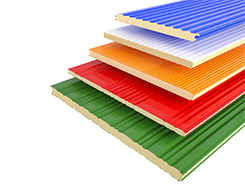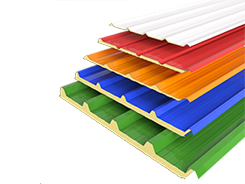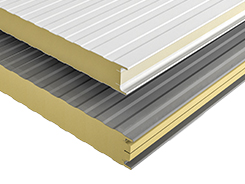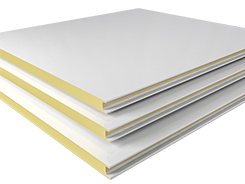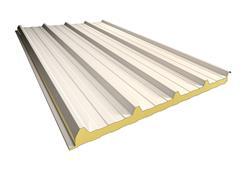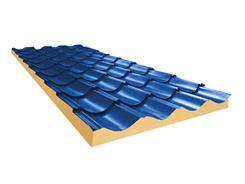Sandwich Panels
Sandwich panel is a stable and light three-layered structure
During the production process, a deeply stable connection is applied between the layers in a way that makes sandwich panels with an integrated structure.
What is a Sandwich Panel? A sandwich panel is a three-layer construction where the top and bottom layers are made of sheets, and the core is filled with foam (typically injected polyurethane foam or rock wool). This innovative building product is custom-produced in various roof and wall panel forms. Prefabricated sandwich panels offer both engineering advantages and economic efficiency. Their advantages include lightweight properties, cost-effectiveness, reusability, thermal insulation, enhanced building performance, etc. With the advent of these panels, traditional building materials such as brick, wood, concrete, cement, and clay tiles, which require significant resources like water, energy, sand, and gravel for production, are gradually becoming obsolete.
Aryabaron Company manufactures a wide range of sandwich panels, including roofing, wall, cold storage, and cleanroom panels, utilizing steel and aluminum sheets, as well as various foams such as XPS, PU, EPS, and PVC. Currently, Aryabaron stands as one of the largest suppliers of sandwich panels in Iran.
Types of Sandwich Panels In Iran
Sandwich panels are divided into 3 types regarding insulation and 2 types regarding application. these different types of sandwich panels are available in a wide range of variety. Usage and calculation are two factors that determine the appropriate type of sandwich panels for any structure. Nowadays, regarding modern machines and C.N.C, there is a great variety of roof and wall sandwich panels.
- Double sided wall sandwich panel
- Hidden screw wall sandwich panel
- Single sheet wall sandwich panel
- Special sandwich panel
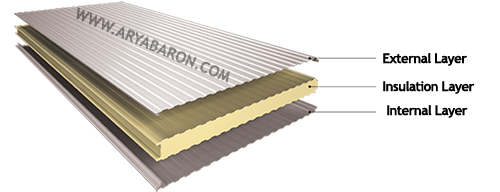
What are sandwich panels?
Roof sandwich panels and wall sandwich panels are fabricated lightweight compounds which consist of two external layers and one core layer that ensure insulation.
Advantages of sandwich panels
- Earthquake resistant
- Beauty and color variety
- Save energy costs
- low maintenance
- high sustainability
- easy transfer and application
- Etc.

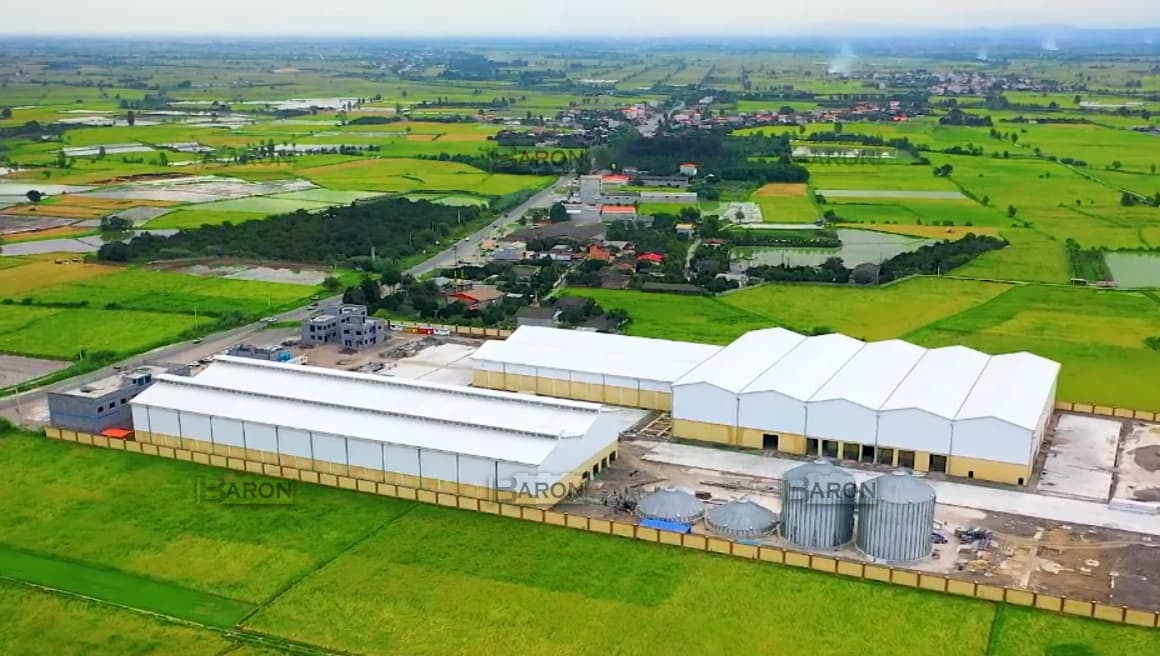
Usage Of Panels
Where to use these panels? Currently this prefabricated product is used to cover the roofs and walls of residential, official, commercial and educational buildings, industrial halls, Coldrooms, clean rooms, hangars, agricultural sheds, gyms, silos, ranches, hen houses, and so on.
Price per Square Meter of Sandwich Panels
The price of sandwich panels, whether 5 cm, 4 cm, 10 cm thick, etc. in wall, roof, cold storage, and cleanroom models, can be obtained by contacting Aryabaron’s sales department. By purchasing Aryabaron sandwich panels (Sandwich Panel – Affordable Prices + Order and Purchase Specifications), you will be utilizing the best alternative to traditional building materials.
The price of sandwich panels depends on several factors related to the building’s technical specifications and usage, the dimensions and thickness of the sheet cover, the type and thickness of the insulating foam, and market and economic conditions. Thus, prices can vary in the market and should be considered based on customer needs and requirements. For instance, sandwich panels with greater thickness and higher quality will cost more.
Manufacturing Factory of Roof and Wall Sandwich Panels
The production line for roof, wall, cold storage, and cleanroom sandwich panels is located in Mashhad and serves as a supplier across Tehran and throughout Iran. In order to purchase and order roof and wall panels, contact Aryabaron’s factory, which holds national standards and international certifications, through the sales department numbers. Aryabaron is the first and foremost manufacturer of sandwich panels in Iran, equipped with the most advanced European production lines (continuous and discontinuous). For elegant, durable, and sustainable sandwich panels, reach out to the Aryabaron sales department. The production process includes auxiliary components, and Aryabaron employs the highest quality auxiliary parts such as 1) top and bottom sheets, 2) core foam, 3) sealing and flashing, 4) connectors, 5) protective coatings, etc.
Factory Address for Different Types of Panels:
No. 34/1, Ayatollah Hashemi Rafsanjani, Ayatollah Hashemi Rafsanjani Expressway (Misagh), Mashhad, Iran
Sale of High-Quality Sandwich Panels
For purchasing ready-to-install sandwich panels, contact Aryabaron Company at (+98)5136228800. The sale of various types of sandwich panels is available in domestic markets and other countries, offered in different designs, colors, and thicknesses, all produced on Aryabaron’s production line.
Aryabaron Sales Showroom Address:
Aryabaron Company, opposite Payambar Azam 77, between Sajjadieh and Ayatollah Hashemi Rafsanjani, Payambar Azam Expressway, Mashhad, Iran
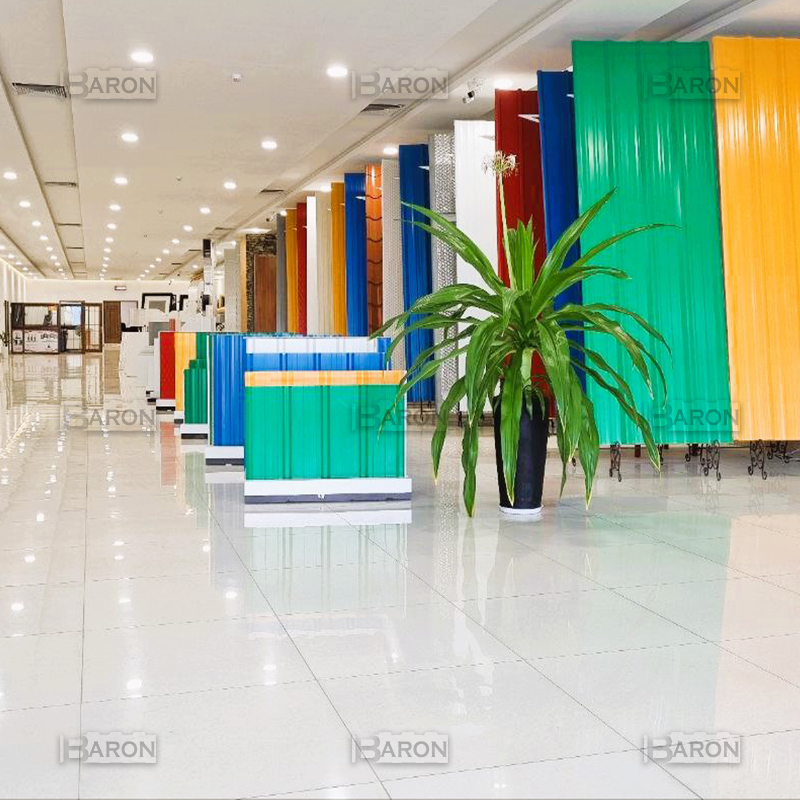
Reducing Construction Costs with Aryabaron Sandwich Panels
The core insulation layer of these products is primarily made of rock wool or polymer products. These materials are inherently low-cost and have extensive production backing. The sheet used in the outer layer of the sandwich panel is not very thick and its price is calculated per square meter.
Using prefabricated components eliminates the need for on-site material preparation and the associated workforce. The operational workshop setup time is significantly reduced due to the increased construction speed, thereby lowering the number of days you incur workshop costs. Compare these aspects with the issues of traditional material execution, and you will find how much using prefabricated sandwich panels reduces your costs.
Superiority of Sandwich Panels in Construction
Given the benefits that sandwich panels offer, their use in all structures with various applications is both technically and economically justified. However, they provide a unique advantage in terms of high-speed execution. Within a short time, you can set up a structure using wall panels. Simply transport these panels to the project site, perform the placement, jointing, sealing, and waterproofing stages. Thereafter, there is no need to wait for materials to set, and you can immediately utilize the space. In the modern era, due to the high speed, frequency, and unpredictability of events, there are urgent requirements for constructing structures for medical, military, industrial, residential, and transportation purposes. These requirements often have a sense of urgency and may dictate that the structure be demolished after the utilization period. Wall sandwich panels help in quickly erecting and easily dismantling structures, making prefabricated sandwich panels an irreplaceable choice for such applications.
Dimensions of Sandwich Panels
The dimensions of sandwich panels are generally determined by the thickness and width of the sheet cover and the type of core, which consists of polyurethane foam or other injectable insulating materials. Typically, the thickness of sandwich panels ranges from 30 to 200 millimeters, and they are produced in lengths from 1 to 12 meters. However, the exact dimensions of each type of sandwich panel may vary depending on the specific application and project requirements, and should be determined according to the needs. Different sandwich panels vary in terms of the thickness of the outer sheet, the inner sheet, and the insulating foam, in various roof and wall models. The wall and roof panel covers are produced in the factory based on different needs and applications.
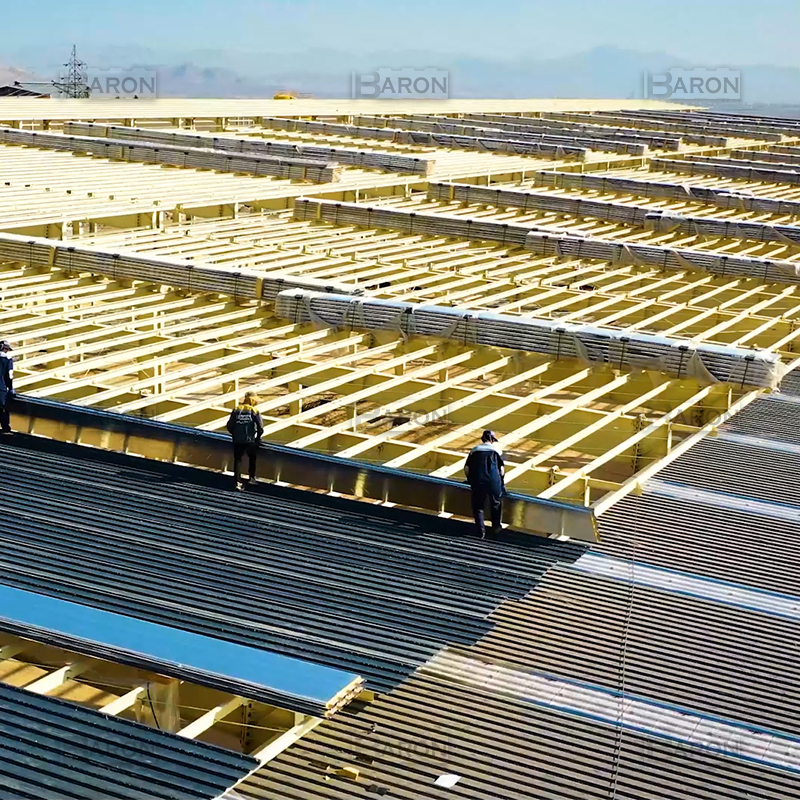
Factors affecting the quality of polyurethane sandwich panels
Quality of the top layer and the bottom layer of the sandwich panel
Based on the usage, the top and the bottom layers are either made of stainless steel, aluminum, copper, PVC, fiberglass, galvanized or pre-painted Aluzinc. Since the Galvanized and Aluzinc sheets are more commonly used, we provide more details about these sheets at this section. As you can see in the following image, the sheet is made of multiple layers and the sheet thickness is in fact the thickness of all these layers combined. the appropriate thickness of the top and bottom layer of a sandwich panel with intended stability is between 0.3 to 0.7 mm, although panels with 0.5 mm thickness is more commonly used and utilizable.
When it comes to the thickness of the sheet it is essential to retain the standard and suitable thickness of layers, especially the base sheet which is the main factor for sustaining stability; so using a nonstandard base sheet which is thinner than standard range, then compensate the thinness with multiple layers of cheap paint to reduce costs is an unprofessional conduct that will never be followed by AryaBaron.
It should also be noted that the epoxy layer behind the sheets is responsible for creating better adhesion between the sheet and polyurethane foam, and if this epoxy layer is removed to reduce costs, the adhesion between the foam and the sheets will not be adequate.
The quality of the paint used to color the sheets, the condition of the production lines and methods of painting, washing and degreasing have an impressive effect on the quality of the pre-painted sheet.
In order to ensure the desired quality and standard of the input sheet is fulfilled in the production lines, Arya Baron prepares the sheets directly from reliable companies such as Mobarakeh Steel Factory, besides all the quality control standard tests are conducted on every product before entering the company’s production line, such as: salt spray test, measurement of paint thickness and paint resistance to bending and crashes.
The quality of the polyurethane foam used in sandwich panels
Polyurethane foam is the product of a combination of isocyanate, polyol and several other additives mixed with catalysts.
The quality of these raw materials has a direct and deep effect on the quality of polyurethane foam of the sandwich panels.
Polyurethanes were first discovered by Otto Bayer in Germany in 1937, and since then these materials, with their special properties, have greatly advanced in various industries around the world. The first polyurethanes were produced from the diisocyanate reaction. Polyurethane (also known as Alitanes) are compounds that have a urethane bond in their structure.
Polyisocyanates (PIR) are chemicals of the same family as polyurethanes, which are mostly used as insulation, and the percentage of MDI in this foam is higher than PUR foam. In equal conditions, the insulation of PIR is more than PUR. PIR’s fire resistance is also higher than PUR’s (B1). Based on new findings, the less is the coefficient heat transfer, the more efficient is the insulation of Polyurethane. This sufficient effect is achieved when the density is ranged between 35 kg/m³ to 50 kg/m³. various tests have been conducted and the results show that the best and most optimal density of sandwich panels in the above range is the density of 41 kg/m³. In many cases, only the density or volumetric mass with the same density of foam is wrongly considered a necessary and sufficient condition for a desirable and high quality foam.
Needless to say, the polyurethane foam is an organic material and its main function is insulation. Now, if this organic matter is mixed with heavy minerals such as mill or rock powder, and even with polyurethane milling materials, the desired density can be easily achieved; While, the desired standard of insulation won’t be achieved and as a result thermal insulation will no longer be at the standard and acceptable level.
The degree of insulation of the foam, which directly depends on its coefficient of heat transfer, is an important quality parameter that requires special attention. With relevant devices, we measure the coefficient of heat transfer and to ensure the purity of foam layers from the presence of unauthorized organic and mineral additives, we use a laboratory microscope. Another important feature of polyurethane foam is its fire resistance, the neglecting of which can lead to severe damage.
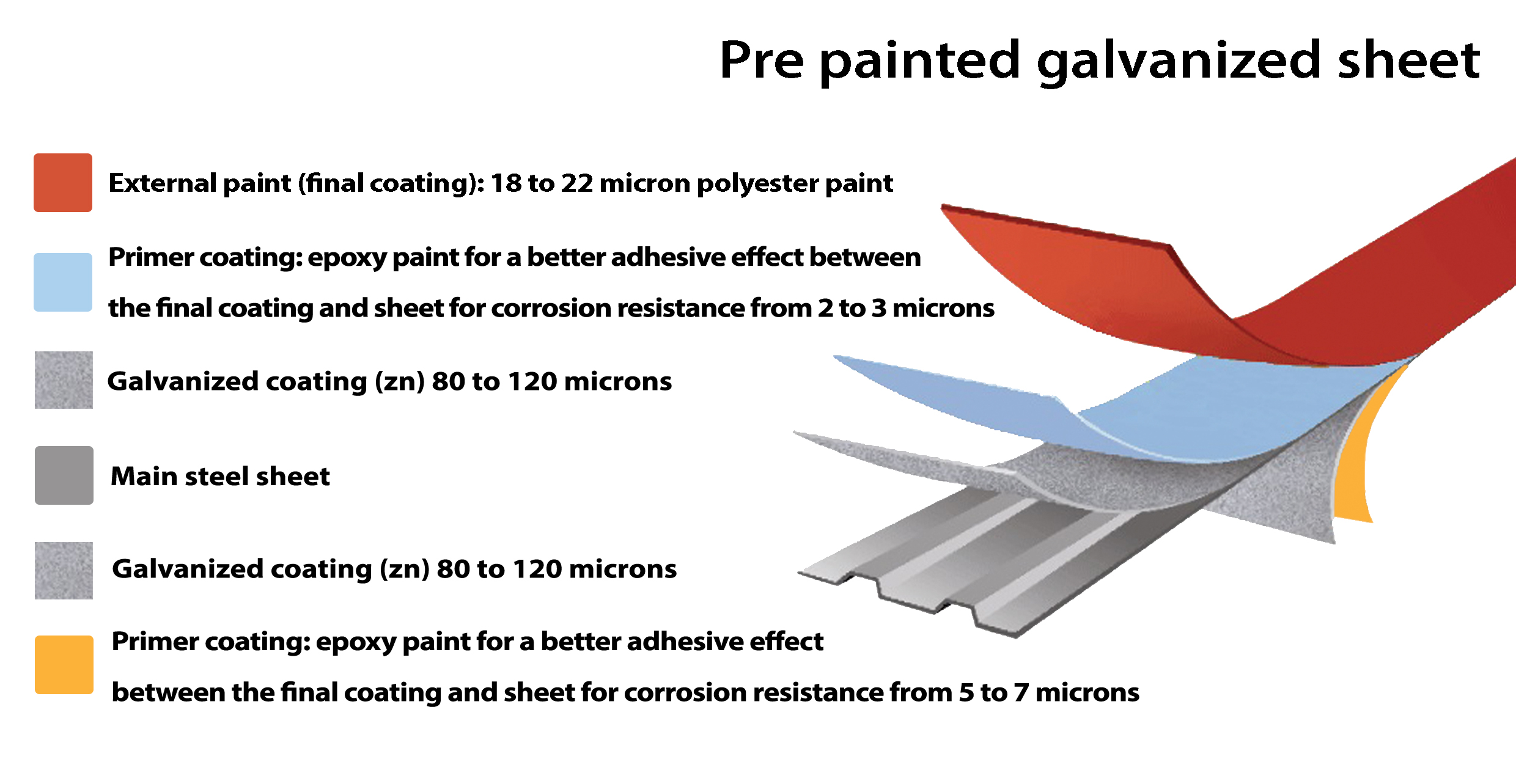
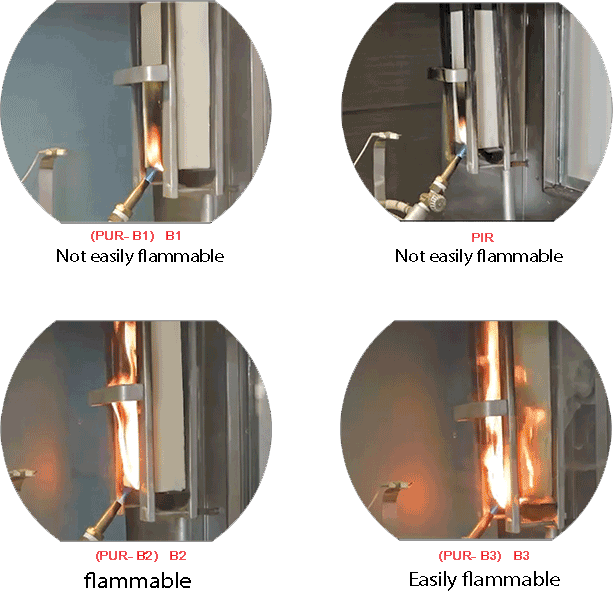
The quality of machines in production line
Polyurethane foam production machines require a high level of technical knowledge, and even some European countries that have been working in the field of producing such machines for many years have not yet been able to achieve the details and tricks of the trade.
Arya Baron believes that the reason behind the expensive manufacturing machines of top quality European brands are their superior quality, and based on this, years ago the company started its activity with advanced polyurethane foam machines from O.M.S. Italy.
Factors affecting the quality of rock wool sandwich panels
The quality of the top layer and the bottom layer and its proper selection
It is worth noting that when it comes to the thickness of the sheet, it is necessary that the thickness of each layer would be standard and suitable, never use a thinner than standard range base sheet which is responsible for the main stability in order to reduce the costs and try to compensate the lack of thickness by using cheap painting layers.
It should also be noted that the epoxy layer behind the sheets is responsible for creating better adhesion between the sheet and polyurethane foam, and if this epoxy layer is removed to reduce costs, the adhesion of the foam to the sheet will not be adequate.
The quality of the paint used to color the sheet, the condition of the production lines and methods of painting, washing and degreasing have an impressive effect on the quality of the pre-painted sheet.
In order to make sure the desired quality and standard of the input sheet is fulfilled in the production lines, ArYa Baron prepare the sheets directly from reliable companies such as Mobarakeh Steel Factory besides, all the quality control standard tests are done on every product before it enters to the company such as: salt spray test, paint thickness measurement and paint resistance to bending and crashes.

The quality of rock wool
Rock wool is one of the best thermal and acoustic insulators that is currently one of the most used materials for insulation all over the world. Rock wool’s thermal stability reaches up to 750 ° C.
Apart from being light, rock wool is non-toxic, recyclable and environment friendly, it also has good physical and chemical dimensional stability. It is also protected against the growth of pests, bacteria and fungi. Thus, rock wool is one of the best thermal and acoustic insulators for the oil, gas, petrochemical, construction and other industries.
In some rock wools, slag from iron furnaces and some molds are used instead of basalt, and to compensate for the shortcomings caused by this misconduct, illegal flammable resins are used more than the standard amount. These rock wools have a much lower fire resistance.

Use of skilled workers in the production process
Skill is a mixture of expertise and experience. And the necessary condition for the optimal use of modern machinery and quality raw materials is the presence of skilled workers in the production cycle. Arya Baron in order to lead the company’s operators and production staff to produce quality and durable products with desirable raw materials and using modern and sophisticated machines at appropriate intervals has considered foreign and domestic training courses and seminars in the company as well as inviting foreign and internal professors and put it in the program of the company.
Production methods and machines
Because rock wool is layered with intertwined fibers, it is inherently soft and easily breakable in layers. For this reason, after the brick rectangles are arranged between the two sheets in a cube, not only is there a gap between the joints, but also the parts of the crotch and the tongue or the overlaps do not have the necessary strength even in the installation stage.
Arya Baron has long sought to fix these two major drawbacks of rock wool sandwich panels so that customers can enjoy the many benefits of these panels without a single worry. In this regard, and to address these two shortcomings, Arya Baron has introduced rock wool sandwich panels to the market by injecting PIR on both sides. In this type of special panels, polyurethane injected at the two side edges in the first stage compresses the rock wool blocks together and eliminates the distance between them, and in the second stage in the crotch and tongue or overlap of the insulation and high strength between Creates top sheet and outsole.
Definitions and units
Density or volumetric or complex mass
To measure how compact an object is, that is, how much space there is in between the components of an object, we need a unit called density. High-density objects have less free space in their crystal lattice. The unit of measurement in SI system for density is kilogram per cubic meter (kg/m3) and the density of an object is calculated by dividing its mass by its volume. The density of an object placed on a scale is obtained from the number of grams (mass of the object) divided by the amount of space occupied by the object (its volume). The density of objects is usually compared to the density of water to see if they float on surface of water or they sink. The density of water is about 1.00 g / mL or 1000kg / m³.
If the physical density is greater than water, it will sink in the water, and if it is less than water, it will float. Usually, the optimum density of polyurethane sandwich panels is between 40 and 44 kg/m3, which is written as 42 ± 2 kg / m³. The conventional density of high-consumption insulation in the sandwich panel industry are as follows:

Insulation
Heat always flows from higher temperature systems to lower temperature systems, and this phenomenon is inevitable. But the rate of this flow can be reduced in a large extent, and this is the main purpose of thermal insulation.
Thermal insulation is a process that reduces the rate of heat transfer between different physical systems and, simply put, prevents the loss of thermal energy of a system as much as possible.
Thermal insulation minimizes the loss of thermal energy in buildings and structures, as well as industrial buildings and equipment, and consequently leads to energy cost savings.
Other benefits of insulation include better temperature control, prevention of frost and equipment breakdown, and all of these benefits depend on the type of insulation and fire resistance.
It is common that in the insulation of buildings and structures, the thermal resistance coefficient (R-value) of insulation is important and the optimality of insulation is measured by this parameter.
Thermal resistance
Thermal resistance is a physical property that indicates the resistance of each material to heat transfer due to temperature differences. Thermal resistance is denoted by R, which has a unit of k/w.
The resistance of insulation materials to conductive heat flow is determined by the thermal resistance R-value. The higher the R-value is, the better the performance of the insulation would be. The R-value depends on the following factors:
- Type of insulation
- Thickness
- Density
The R-value of polyurethane foams is higher than other types of insulation materials, which makes it a good insulation material.
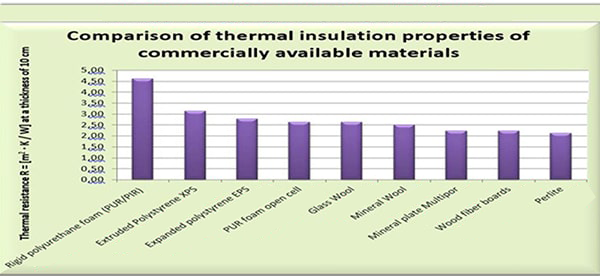
Thermal Insulation
Each industrial or natural material has its own thermal conductivity. Thermal conductivity is the amount of thermal energy that matter can pass per unit of area, unit of thickness, unit of time, and at a given temperature. The lower the thermal conductivity, the lower the heat transfer capacity and the more suitable the insulation. Since heat is always flowing from a warmer environment to a colder one, it is necessary to choose the best insulation suitable for the environment with the appropriate density to save energy costs.
The following figure shows how thick the different materials are in terms of insulation. For example, instead of a 172 cm thick brick wall, a 5 cm thick polyurethane wall will suffice

Coldroom sandwich panel
One of the challenges of coldrooms, whether during installation or operation, is the proper connection and precise sealing of the sandwich panels to each other. Although the skill of installation and accuracy is also effective in this issue, the crotches and tabs should be produced in a standard and organized manner, that is proper design of the geometric shape, accuracy in dimensions, absence distortion and contact surface material. The best way to improve the air quality of coldrooms is to reduce the number of joints between the sandwich panels. For the first time in Iran, Arya Baron succeeded in producing wide coldroom sandwich panels with a width of 120 cm. When the walls and ceiling of a cold store are covered with 120 cm wide sandwich panels, the number of joints is reduced by 20% compared to the traditional 1-meter-wide sandwich panels, or in other words, the challenge of sealing the coldroom without any changes using just a wide panel is reduced by 20%.
Shadow line sandwich panels
Shadow line sandwich panels are among the exclusive products of Arya Baron Toos brand. Shadow line sheet is one of the most widely used sheets for making sandwich panels. The use of this sheet has several advantages, including the reasonable price, high strength and durability, as well as its quick and easy installation.
AryaBaron Company; Manufacturer of Sandwich Panels, Refrigerator Doors, Conex Boxes, Prefabricated Buildings, Industrial sheds and pre-insulated ductwork is one of the largest exporters in Iran. Offering the highest quality products and using the latest European advanced product lines is AryaBaron’s top priority. AryaBaron is the symbol of trust and quality of Iranian products.
Why are Sandwich Panels a Suitable Replacement for Traditional Building Materials?
The reasons why sandwich panels are a suitable alternative to traditional building materials are numerous.
The very low weight of the various thermal insulations used in the core layer significantly reduces the weight of sandwich panels. A wall made of sandwich panels can be up to fifty times lighter than its cement or brick counterparts. This is particularly important for earthquake resistance and reducing ancillary costs.
The structure and lightweight nature of sandwich panels compared to traditional building materials result in a very high resistance to various compressive and impact loads. The applied force is well absorbed by these panels, neutralizing impact forces.
Another significant point is that unlike conventional concrete walls, sandwich panels do not suffer from corrosion damage due to humidity and weather conditions. This minimizes maintenance and repair costs.
Another crucial advantage of sandwich panels over traditional building materials is their quick installation and execution. They can be disassembled and reused, and they also offer the ability to expand and modify the dimensions of constructed spaces quickly and with minimal waste.
Compared to traditional building materials, sandwich panels have much lower energy loss, leading to long-term reductions in heating and cooling costs.
The speed of panel installation is incomparable to traditional construction methods. With a three-person crew, up to 400 square meters can be installed daily. Overall, the installation speed is 50 times faster than traditional walls.
The main advantage of sandwich panels over traditional materials is the insulating foam inside, which provides thermal, cold, and moisture insulation.
How Much Do Aryabaron Sandwich Panels Cost?
Given the mentioned features, the cost of sandwich panels is very reasonable and economical. Using the latest global machinery and experienced technical staff, Aryabaron factory currently produces and markets the best and highest quality sandwich panels. For more information on the prices of Aryabaron sandwich panels, please contact the numbers provided on the website.
Why Aryabaron Sandwich Panels?
Aryabaron factory produces standard sandwich panel coverings. With its sales representatives for various sandwich panels in Tehran, Mashhad, Shiraz, Isfahan, etc., it provides building panels at the latest prices for those active in the construction industry.
Consider the following when selecting Aryabaron panels:
- Competitive pricing
- Variety of colors
- High installation speed
- Extremely lightweight
- Utilization of modern and fully automated machinery
Explore Aryabaron’s non-combustible and fire-retardant sandwich panels.
Advantages of Using Aryabaron Sandwich Panels
Using this innovative product offers various advantages, including:
- Reducing external noise within the environment
- Effective thermal and cold insulation
- Easy and quick installation
- Reusability
- Cost reduction and affordable prices
- Fire resistance
- Resistance to corrosion and rust
- Very easy transportation
- Usable in all weather conditions
- Variety of designs and colors
- High durability and longevity of the structure
- Lightweight
- Suitable for all climatic conditions
- Low maintenance costs
- Easy disassembly and relocation of the structure
- Ability to repair and replace a section of the structure
- Washable, rust-proof, and low water absorption
- Stable load-bearing capacity against earthquakes and lateral forces
- Increased lifespan of the structure
Another goal pursued in structural engineering is the lightweight and rapid construction of structures. Sandwich panels are lighter and less bulky compared to other materials. These panels are pre-fabricated in the factory and only need to be positioned and installed on-site. This significantly speeds up the construction process. Due to their insulation properties, sandwich panels are resistant to sound, water, cold, and heat penetration. Transporting and installing these panels is much easier than traditional materials and they require less labor for the installation process.
Which Factory is the Largest Producer of Sandwich Panels?
Aryabaron Company is one of the largest producers of Sandwich Panels in Iran. It utilizes the latest fully automated sandwich panel production line to manufacture innovative building products with the highest quality. Various companies produce sandwich panels and the diverse features and raw materials used in the construction of the panels might be suitable criteria for choosing the best panel. Due to the export of Aryabaron’s sandwich panels, it can be stated that the products of this factory are among the best modern building materials.
Sandwich Panels in Tehran
With its sales agency in Tehran, Aryabaron offers roof panels and wall panels at competitive prices and excellent quality.
History of Sandwich Panel Construction and Use
Sandwich panels were first used for the construction of train and airplane bodies and roofs, where high strength was required. The initial production of sandwich panels began in the 1930s, leading to their increasing and widespread use. Nowadays, sandwich panels are used in various industries, including construction, military, shipbuilding, and train manufacturing. Their light weight, excellent insulation, and extraordinary strength have contributed to the growing utilization of these modern building materials. The ease of installation, reasonable cost, reusability, and thermal insulation properties of Aryabaron’s sandwich panels have made them a key element in all modern structures.
Types of Sandwich Panel Sheets Produced in Iran
The technical and engineering aspects of sandwich panel sheets, whether single or double-sided, include several key factors:
1. Sheet Thickness
2. Paint Thickness
3. Epoxy Layer beneath the Sheet
4. Reputation of the Sheet Manufacturing Company
Guides to Ordering and Purchasing Sandwich Panels in Iran
To order and purchase various types of building sandwich panels, contact Aryabaron’s sales department. Aryabaron provides ready-to-sell sandwich panels to its sales representatives across Iran.
Delivery Time of Sandwich Panels
The delivery time for sandwich panels varies depending on the destination and the order quantity. For more information, contact the Aryabaron sales department. Panels can be produced in various sizes and insulations, with two common thicknesses being 4 cm and 3 cm.
Where to Use Sandwich Panels
Due to their classification as modern building materials, sandwich panels can be utilized in a wide range of environments and conditions. For instance, they are suitable for use in industrial locations, factories, office buildings, and construction projects. They can be directly applied in many cases, while in others, they might be used indirectly.
Quality Considerations When Ordering Panels
Purchasing low-quality panels not only imposes the cost of repurchasing materials on the project expenses but also leads to various other damages such as structural deterioration, collapse of prefabricated buildings, lack of insulation in the structure, etc. Therefore, it is recommended to pay special attention to quality parameters when purchasing sandwich panels and other modern building structures online.
Where to View the Colors of Aryabaron’s Sandwich Panels
To select the color of Aryabaron’s sandwich panels, simply specify your preferred color when placing your order. You can view the available colors of the sandwich panels before making a purchase.
Impact of Panel Color on Building Appearance
One of the advantages of using sandwich panels is the ability to select from a variety of colors. These modern building materials are designed and produced in diverse colors. Therefore, the customers can select panels that match their preferences and enhance the aesthetic appeal of their structures.
What is insulation foam or core material in sandwich panels?
The insulation layer or core layer of sandwich panels is one of the most important materials that significantly impacts the performance, cost, and other aspects of sandwich panels. Various companies use different types of core insulations for sandwich panels. Three of the most popular types of foam sandwich panels include:
- Polyurethane foam insulation layer (Polyurethane)
- Rock wool foam insulation layer (Rock wool)
- Polystyrene foam insulation layer (Polystyrene)
What are the stages of sandwich panel production and the production technology?
Generally, the production process of sandwich panels involves two main methods: continuous and discontinuous methods. An explanation of each method is provided in the following:
- Continuous Method:
In this method, all stages of sandwich panel production are carried out by robots and mechanical arms on the production line. Raw materials are directed from a specific reservoir to the production line, where mechanical arms undertake the design and construction of sandwich panels. The finished sandwich panels are then cut and removed from the other end of the machine. In a sense, all production stages are continuous and interconnected in this method.
- Discontinuous Method:
In the discontinuous production method, the process of designing and constructing sandwich panels is not continuous. This means that each stage of the design is carried out separately, and the panel is moved to the next work station for the next step.
Generally, a sandwich panel production line consists of several stages. Depending on the size and type of the project, various equipment and machinery are used for the production and standardization of panels. These production lines include the following stages:
- Cutting for sheet covering: The sheet covering is cut according to technical drawings and dimensions using specific cutting machines and designated parts.
- Foam injection: In this stage, the interior space between the two cover sheets is filled with polyurethane foam injection. The foam takes shape according to the desired pattern for use in industrial buildings.
- Bonding sheets: In this stage, the covering sheets are bonded to the foam. Special adhesive and fastening machines are used for this process.
- Up-lifting and cutting: In this stage, the sandwich panels are cut into various sizes and thicknesses and prepared for transportation and installation at the construction site. Special machines are used for lifting and cutting them.


